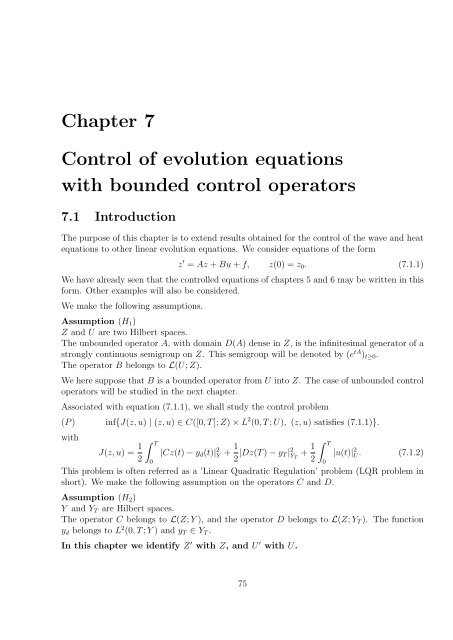Optimal Control of Partial Differential Equations
Optimal Control of Partial Differential Equations
Optimal Control of Partial Differential Equations
Create successful ePaper yourself
Turn your PDF publications into a flip-book with our unique Google optimized e-Paper software.
Chapter 7<br />
<strong>Control</strong> <strong>of</strong> evolution equations<br />
with bounded control operators<br />
7.1 Introduction<br />
The purpose <strong>of</strong> this chapter is to extend results obtained for the control <strong>of</strong> the wave and heat<br />
equations to other linear evolution equations. We consider equations <strong>of</strong> the form<br />
z ′ = Az + Bu + f, z(0) = z0. (7.1.1)<br />
We have already seen that the controlled equations <strong>of</strong> chapters 5 and 6 may be written in this<br />
form. Other examples will also be considered.<br />
We make the following assumptions.<br />
Assumption (H1)<br />
Z and U are two Hilbert spaces.<br />
The unbounded operator A, with domain D(A) dense in Z, is the infinitesimal generator <strong>of</strong> a<br />
strongly continuous semigroup on Z. This semigroup will be denoted by (e tA )t≥0.<br />
The operator B belongs to L(U; Z).<br />
We here suppose that B is a bounded operator from U into Z. The case <strong>of</strong> unbounded control<br />
operators will be studied in the next chapter.<br />
Associated with equation (7.1.1), we shall study the control problem<br />
(P ) inf{J(z, u) | (z, u) ∈ C([0, T ]; Z) × L 2 (0, T ; U), (z, u) satisfies (7.1.1)}.<br />
with<br />
T<br />
J(z, u) = 1<br />
|Cz(t) − yd(t)|<br />
2 0<br />
2 Y + 1<br />
2 |Dz(T ) − yT | 2 1<br />
YT + |u(t)|<br />
2 0<br />
2 U. (7.1.2)<br />
This problem is <strong>of</strong>ten referred as a ’Linear Quadratic Regulation’ problem (LQR problem in<br />
short). We make the following assumption on the operators C and D.<br />
Assumption (H2)<br />
Y and YT are Hilbert spaces.<br />
The operator C belongs to L(Z; Y ), and the operator D belongs to L(Z; YT ). The function<br />
yd belongs to L 2 (0, T ; Y ) and yT ∈ YT .<br />
In this chapter we identify Z ′ with Z, and U ′ with U.<br />
75<br />
T

















